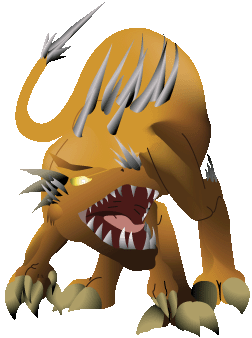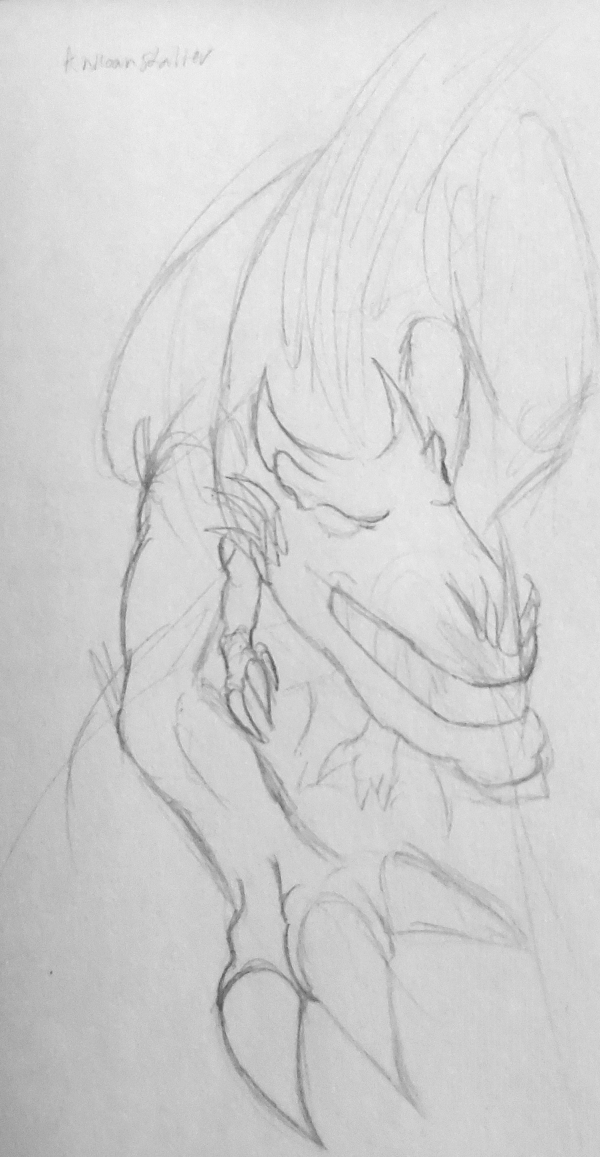Khilioan Stalker (KEEL-Oh-an)
Sheer, savage, instinct...
Nothing should live on Planet Khilio, third in the Thurukian System, and yet sandwiched between the Twin Suns thrives an ecosystem on a far more inhospitable world than even Planet Thunthen. There are no ancient ruins or secrets therein, or relics of failed civilizations. There is predator and prey, and chief among predators is the Stalker. From the second they are born they race against time and the heat of the Twin Suns to kill and feed until they die of old age or are caught unawares as the suns rise. Once believed to be a distant relative of the Thunthen, there is no genetic relation to either the Dragonmen nor ancient dinosaurs of the Oldworld. How this six-limbed killer came into existence and how it endured up until present remains a mystery few are willing to brave either the heat or the Stalkers' hunger to plumb.
Basic Information
Anatomy
Stalkers are sextapeds with four stocky fore and hind limbs and a pair of smaller dexterous limbs close to their clavicle. A long whiplike tail tipped with long narrow spikes trails behind them and a cluster of spikes protrudes from their back between the shoulder and hip. They are possessed of lean muscle and covered in thick orange hide. The skin around their throats hangs loose and additional spikes adorn their jaws and nasal ridges.
Biological Traits
Due to the hazardous environment and the lack of suitable long-term shelters, it is suspected that Stalkers reproduce asexually and give birth to live offspring, fully-formed and ready to hunt as soon as the amniotic sac dries. This has not been witnessed first hand thus far, and only the persistent existence of the predator population gives testament to their survival. Their exact lifespan remains a mystery, and the lack of expired remains indicates they engage in a form of cannibalism: those that fail to kill or die from illness or old age are themselves consumed to sustain their fellows. There is no room for weakness of any kind.
Genetics and Reproduction
All explorers have to go by are theories since the last time a Thunthen attempted to observe the daily habits of a Stalker from the relative safety of a skybike, the creature vaulted high enough into the air to tackle a fully-grown Nobeyl out of the seat. The attack almost seemed vindictive as the energy expended making such a powerful jump versus energy gained would negate each other.
Growth Rate & Stages
The lack of baby or juvenile specimens being sighted only lends credence to the asexual reproduction theory. The smallest Stalker ever observed was about the size of a fully-grown Tibetan tiger.
Ecology and Habitats
Planet Khilio has an unusually dense atmosphere and strong gravity for one of the "Inner Worlds". A living specimen has never been captured or transported successfully by either Thangien nor Thunthen explorers both due to the hazard of even being in close proximity to a Stalker and due to the adverse effects of leaving the pressurized environment. The first attempt to sedate and retrieve a specimen resulted in the skin sloughing off rather painfully and the bones liquefying from the inside out. It is theorized a specially-crafted container capable of replicating the conditions of the surface might suffice for transportation, but neither major race has the stomach for such an endeavor.
Stalkers spend roughly 80% of their time hunting and 20% sleeping and eating. While they can tolerate the heat of the Twin Suns, they cannot withstand it for long periods of time and will create burrows in the rocky soil or seek shade in what caves or overhangs to be found on the baked surface. The lack of standing bodies of water gives rise to the theory that any moisture gained is accumulated via the nasal passages and stored in internal bladders tucked beneath the throat. Certainly their thirst cannot be solely slaked by the blood of their kills....?
Dietary Needs and Habits
Stalkers are solely carnivores, zeroing on anything with a pulse. Their favorite prey is an armored mammal similar to an armadillo or pangolin, but the reflective scales meant to keep extreme heat at bay do nothing against the deft claws of the Stalkers. Thunthen scientists insist it must have some form of intelligence since Stalkers go through great effort to peel the skin off of their prey then bat them around almost cruelly until the exposed flesh is covered in the mineral-rich soil. They heap additional layers of soil atop the still-writhing victim then retreat to find shelter and wait patiently for the Twin Suns' zenith to pass then re-emerge to feast on their kill-now effectively baked through and through.
Thangiens counter that baking is the only way for Stalkers to safely digest critical minerals, now imbued in the cooked flesh of the slain victim. In any case, even the mightiest Nobeyl or experienced Metraind will give pause upon seeing a Stalker pinning down prey of similar size with its powerful forelegs while flaying off the protective skin with its smaller "collar claws". Stalkers often engage in surplus killing, either to ensure quick access to food or to "store" food for later.
Additional Information
Social Structure
Stalkers have never been observed congregating in significant numbers, either for migration or reproduction. They do not seem to engage in rut aggression, focusing almost all of their time and effort on hunting. Whether they look after their young even for a moment is a matter of some debate. Thunthen insist there must be some form of interaction in order to exchange genetic material and keep DNA from stagnating, theorizing Stalkers possess rows of organs along their legs or tails much the way lizards do, but this theoretical interaction has yet to be observed and no explorer would dare getting close to try.
Facial characteristics
A cluster of bony spikes adorn the tip of the nose, presumably used to throw a victim off balance and flip them onto their back, rendering them vulnerable. The smaller rows of spikes and protrusions along the jaw are thought to be a form of heat distribution to facilitate internal cooling. They sport quite the underbite, relying on their powerful jaws to bear down unruly prey. The membrane over their eyes gives them the appearance of having no pupils, though it is suspected they actually have compound eyes.
Geographic Origin and Distribution
The exact population remains unknown, but Stalkers seem to prefer the farthest zone of either hemisphere away from the equator, migrating periodically if local populations begin to dwindle. Because they rely on a steady supply of prey, they seem to rotate territories in order to let herds replenish.
Average Intelligence
They are incapable of any form of communication, verbal or visual. They seldom even roar in order to conserve precious moisture, making their silence while hunting even more terrifying. Being solitary hunters, they will not participate in the hunts of other Stalkers but in a perverse form of consideration will go out of their way to avoid pillaging the cached kill of another Stalker. They seem to be able to differentiate between carcasses due to scent markers left behind during the burying process. Due to their nictitating membrane, they do not respond to any gestures.
Perception and Sensory Capabilities
Stalkers spend virtually every waking moment searching for the next kill. They can zero in on a grain of sand knocked loose by a footstep and differentiate it from one of their own. Unlike the Thunthen, Stalkers possess a pseudo Jacobson's Organ through which they can detect any prey within a mile radius with a flick of the tongue. They rely on hearing and smell far more than sight. A nictitating membrane slathered in mucus protects their eyes from the crushing heat of the Twin Suns. They rely on their eyes only as much as they need to seek shelter or fix the position of their target as they close in for the kill.
Symbiotic and Parasitic organisms
It is suspected moisture-hoarding organisms take up residence inside the chest cavity and throat pouches of Stalkers: in exchange for supplying steady amounts of protein, organisms fix and share precious residual water.
Civilization and Culture
History
Stalkers are a fairly recent discovery. The Thunthen sent expeditions to survey the planet seeking additional resources, and perhaps an ore capable of bonding with spectra. While they did discover deposits of phergon, Stalkers quickly swarmed their forward base in a frenzy and the expedition had to be aborted. Additional attempts at establishing observation bases or mining outposts have ended in failure. The dense atmosphere and withering heat would be fatal to a Pegacorn, and even fully-enclosed armor provides limited protection from the environment, however with the advent of the Pegasi, Thangiens have launched operations to harvest as much raw phergon as possible in the short span of time before Stalkers zero in.
"Even the Stalkers of Khilio exhibit rudimentary intelligence. They skin their prey alive and roll them about in the mineral-rich topsoil, then leave the bodies to bake in Thuruk 2’s heat, returning at nightfall to feed.”- Bak Thraplek to Raeo Flamerider
Lifespan
Unknown
Average Height
7'-8'
Average Weight
600-1200 lbs
Average Length
15'-20'
Average Physique
While the lower limbs are built to sustain almost constant movement, Stalkers store a great deal of body fat along the back, thighs, and ribcage. These reserves are only meant to last in the event of a missed kill opportunity. Their bodies are far too heavy and the gravity too strong for them to stand on their hind legs for longer than a few seconds, thus they must rely on their forelimbs and collar claws to do most of the work.
Body Tint, Colouring and Marking
One reason early Thunthen explorers were so convinced Stalkers were some distant relative was their orange-yellow skin, however their hide appears leathery and beady, like a cross between a rhinoceros and a Gila monster. Without the need for courtship, there are no differentiating characteristics aside from slight variations in size. The cluster of spikes on the tail is thought to serve as a weapon by which to stab prey in vulnerable locations.
Related Materials
“My brother leads raids to Planet Khilio to retrieve fresh supplies. It is the only other place it can be harvested…besides Planet Thunthen…”-Australapaela





Comments